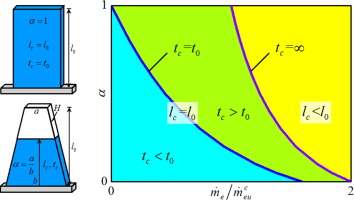当前位置:
X-MOL 学术
›
Int. J. Heat Mass Transf.
›
论文详情
Our official English website, www.x-mol.net, welcomes your
feedback! (Note: you will need to create a separate account there.)
Tuning capillary penetration in porous media: Combining geometrical and evaporation effects
International Journal of Heat and Mass Transfer ( IF 5.0 ) Pub Date : 2018-08-01 , DOI: 10.1016/j.ijheatmasstransfer.2018.02.101 Mingchao Liu , Jian Wu , Yixiang Gan , Dorian A.H. Hanaor , C.Q. Chen
International Journal of Heat and Mass Transfer ( IF 5.0 ) Pub Date : 2018-08-01 , DOI: 10.1016/j.ijheatmasstransfer.2018.02.101 Mingchao Liu , Jian Wu , Yixiang Gan , Dorian A.H. Hanaor , C.Q. Chen

|
Abstract Capillary penetration of liquids in porous media is of great importance in many applications and the ability to tune such penetration processes is increasingly sought after. In general, liquid penetration can be retarded or restricted by the evaporation of volatile liquid at the surface of the porous media. Moreover, when capillary penetration occurs in a porous layer with non-uniform cross section, the penetration process can be accelerated or impeded by adjusting the section geometry. In this work, on the basis of Darcy’s Law and mass conservation, a theoretical model of capillary penetration combining evaporation effects in two-dimensional homogeneous porous media of varying cross-section is developed and further examined by numerical simulations. The effects of sample geometry and liquid evaporation on capillary penetration are quantitatively analyzed. Results show that the penetration velocity is sensitive to the geometry of the porous layer, and can be tuned by varying the evaporation rate for a given geometry. Under given evaporation conditions, penetration is restricted to a limited region with a predictable boundary. Furthermore, we find that the inhibition of liquid penetration by evaporation can be offset by varying the geometry of the porous layer. The theoretical model is further extended to model the capillary flow in three-dimensional porous media. The interplay of geometry and evaporation during the capillary flow process in 3D conditions is also investigated. The results obtained can be used to facilitate the design of porous structures to achieve tunable capillary penetration for practical applications in various fields.
中文翻译:

调节多孔介质中的毛细管渗透:结合几何和蒸发效应
摘要液体在多孔介质中的毛细管渗透在许多应用中具有重要意义,并且越来越需要调整这种渗透过程的能力。通常,液体渗透可以通过挥发性液体在多孔介质表面的蒸发而延迟或限制。此外,当毛细管渗透发生在横截面不均匀的多孔层中时,可以通过调整截面几何形状来加速或阻碍渗透过程。在这项工作中,在达西定律和质量守恒的基础上,开发了一种结合蒸发效应在不同截面的二维均质多孔介质中的毛细管渗透理论模型,并通过数值模拟进一步检验。定量分析样品几何形状和液体蒸发对毛细管渗透的影响。结果表明,穿透速度对多孔层的几何形状很敏感,并且可以通过改变给定几何形状的蒸发速率来调整。在给定的蒸发条件下,渗透仅限于具有可预测边界的有限区域。此外,我们发现蒸发对液体渗透的抑制可以通过改变多孔层的几何形状来抵消。该理论模型进一步扩展到模拟三维多孔介质中的毛细管流动。还研究了 3D 条件下毛细管流动过程中几何形状和蒸发的相互作用。
更新日期:2018-08-01
中文翻译:

调节多孔介质中的毛细管渗透:结合几何和蒸发效应
摘要液体在多孔介质中的毛细管渗透在许多应用中具有重要意义,并且越来越需要调整这种渗透过程的能力。通常,液体渗透可以通过挥发性液体在多孔介质表面的蒸发而延迟或限制。此外,当毛细管渗透发生在横截面不均匀的多孔层中时,可以通过调整截面几何形状来加速或阻碍渗透过程。在这项工作中,在达西定律和质量守恒的基础上,开发了一种结合蒸发效应在不同截面的二维均质多孔介质中的毛细管渗透理论模型,并通过数值模拟进一步检验。定量分析样品几何形状和液体蒸发对毛细管渗透的影响。结果表明,穿透速度对多孔层的几何形状很敏感,并且可以通过改变给定几何形状的蒸发速率来调整。在给定的蒸发条件下,渗透仅限于具有可预测边界的有限区域。此外,我们发现蒸发对液体渗透的抑制可以通过改变多孔层的几何形状来抵消。该理论模型进一步扩展到模拟三维多孔介质中的毛细管流动。还研究了 3D 条件下毛细管流动过程中几何形状和蒸发的相互作用。











































 京公网安备 11010802027423号
京公网安备 11010802027423号